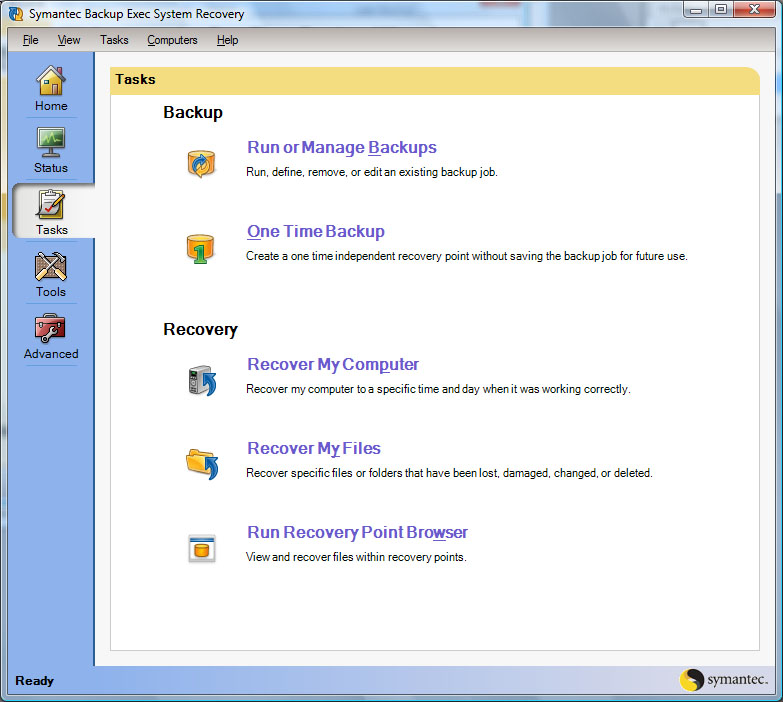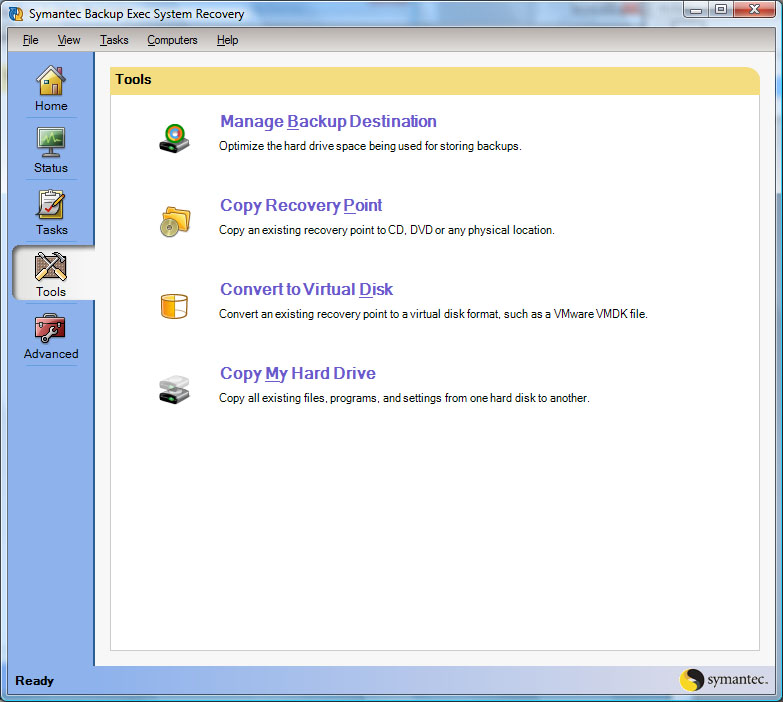|
Symantec Backup Exec System Recovery 8 Desktop
Edition
Symantec's Backup Exec returns, featuring a plethora of new options in
Symantec Backup Exec System Recovery 8 Desktop Edition that is the
probably the most definitive backup software available. My personal
favourite feature of this utility is the “Offsite Backup Copy” which allows you to create recovery
points to an offsite destination through FTP, network sharing or
external hard drives, ensuring a broader range of options should a
doomsday scenario occur. Users using USB drives will be pleased to know
that even if your drive letter changes, the software intelligently
communicates to the USB drive, ensuring a flawless backup. How's that
for some great new features?

Key Features
-
Recover complete Windows
desktops or laptops in minutes to same hardware, dissimilar
hardware or virtual environments with the Restore Anyware™
technology
-
Create real-time,
while-you-work recovery points of the entire system and save
to any disk-storage device
-
Enables offsite backup copy
to an FTP location or secondary disk drive for enhanced
disaster recovery capabilities
-
Search and retrieve files
and folders in seconds via Google Desktop or Backup Exec
Retrieve
|
Key Benefits
-
Rapid and reliable system
recovery even from a bare-metal state, without the need to
reinstall and reconfigure operating systems, applications,
system settings, and preferences.
-
Eliminate backup windows by
capturing the entire live Windows system, without disrupting
user productivity or application usage
-
Simplifies and extends your
data and disaster recovery capabilities
-
Centrally manage backup and
recovery tasks for multiple desktops/laptops across your
entire organization (via Backup Exec System Recovery
Manager)
|

What sets Symantec Backup Exec System Recovery apart from its
competitors is the intuitive and simple to use interface that no matter
what your computer experience is, you should have no issues whatsoever
in mastering this powerful software package. The interface is neatly
divided into a variety of menus on the top (File, View, Tasks,
Computers, Help) and a list of icons in the left navigation pane which
include Home, Status, Tasks, Tools and Advanced. By clicking on either
of those icons, it will bring up the relevant section in the main right
window pane.
The Home icon will give you a status of your backup and allows the user
to manage their backups, recover their computer or files with just a
click of a button for some great backup wizards. The Status area
displays a calendar which displays your recovery points for your various
backups and when the backup last occurred. Tasks is where the user
manages their backups and also recover their files and computer.
Tools
offers the user to manage their backup destination, copy a recovery
point, convert to virtual disk and copy their hard drive from one to
another. Lastly, for the more experienced user is the Advanced area which
gives the user a variety of more user defined options plus some
extremely in-depth logs and progress views.

New
Features
Innovative technologies in
Backup Exec System Recovery
enable you to recover complete
Windows systems in minutes, not
hours or days, making Backup
Exec System Recovery the gold
standard in complete Windows
system recovery
Offsite Backup Copy
Automatically copy recovery
points (backups) to a remote
server using FTP or to an
external hard drive or
network share to enhance
your disaster recovery
efforts
Symantec ThreatCon
Integration
Easily configure Backup Exec
System Recovery to
automatically run a backup
when the Symantec ThreatCon
level reaches or exceeds the
level specified. This
feature ties directly into
Symantec's global DeepSite
ThreatCon infrastructure.
USB Drive Identification
Backup Exec System Recovery
intelligently and uniquely
communicates to USB drives,
running backup jobs to the
given device even if the
drive letter changes.
Flexible Data Recovery
Capabilities
Backup Exec System Recovery
Desktop Edition delivers
many data recovery
capabilities, simplifying
the recovery of individual
files and folders. Features
include:
-
Recovers individual
files and folders in
seconds from either
recovery points or
file/folder backups
-
Enables end-user
recovery of files and
folders via Google
Desktop or Backup Exec
Retrieve using a common
web-browser interface
for fast and simple
recovery, without IT
intervention
Revolutionary, Simple User
Interface
Calendar view shows past,
present and future recovery
points and the protection
level for each volume on the
system, including backed up,
attention needed or at risk.
Dissimilar Hardware
Restoration with Restore
Anyware
Rapid recovery of entire
systems to dissimilar
hardware breaks the barrier
of incompatible storage
controllers and hardware
abstraction layers, thereby
reducing recovery times and
saving significant hardware
investments. Combines
hot-imaging with the ability
to restore to different
hardware platforms on the
fly.
Continued Virtual Support
Leverages the power of
virtualization, enabling
seamless physical to virtual
(P2V) and virtual to
physical (V2P) conversions
for VMware ESX Server,
VMware Server (formerly GSX
Server), VMware Workstation,
and Microsoft Virtual Server
disk formats. Convert entire
systems at once or select
volumes at a time.
-
Easy-to-use, intuitive
virtual conversion
wizard allows for quick
conversion directly to
VMDK or VHD files
-
Allows for pre-flight
testing of patches,
installations in the
virtual environment
before applying changes
to production systems
Customizable Symantec
Recovery Disk
Simplifies and speeds system
recovery by allowing IT
administrators to build
their own recovery
environment with drivers
unique to their hardware
needs. It automatically
harvests system drivers from
the system on which the
customizable SRD is being
created. It also allows for
manual inclusion of
additional 3rd party drivers
with the ability to burn to
CD or .iso format.
Customizable Event Driven
Recovery Points
Allows users to specify
executable(s) or .com files
for which recovery points
should be triggered. Users
can also select to
automatically capture
recovery points prior to
application installation,
user logon or logoff, and
configurable storage
utilization changes.
Integration with Altiris
Notification Server 6.5
Manage system backup tasks
directly in Altiris Notification
Server 6.5 using Backup Exec
System Recovery and the Backup
Exec System Recover Integration
Component for Altiris.
Review (Continued...)
Speed is a major factor in backup software and we were pleased to report
that Backup Exec System Recovery Desktop Edition is one of the fastest
programs on the market which was on our Windows Vista 64-bit operating
system with 4GB of RAM and an AMD Phenom 9600 CPU.
However it should be
noted that it is impossible to accurately measure backup speeds due to
the complexities of systems and files but given our experience, we can
report that this program has a huge edge over its competitors. Best of
all, restoring files or even complete operating systems was as simple as
clicking an icon and “presto”, the software began restoring the entire
hard drive. Even over our wireless network, the speed was constant and
successfully restored.
Although selecting what files you wished to restore, times or entire
hard drive contents have been a feature in most backup utilities, Backup
Exec System Recovery Desktop also features a similar premise, however
with the inclusion of “Google desktop” and the web-based interface,
those budding system administrators or novice users will easily be able
to restore those individual files, folders or entire hard drives.
Previous users will be pleased to know that Symantec goes beyond their
existing virtual drives by supporting a plethora of standards and my second
favourite aspect, the ability to install software on the virtual
environment before installing it onto the production software. Needles
to say, a very important feature that is extremely important in this day
and age of upgrades and updates.
The system requirements of Backup Exec System Recovery Desktop are quite
low which is perfect for individuals or organisations with budgetary
constraints. Best of all (again), the product supports a variety of Windows
operating systems from Windows 2000 Professional to Windows Vista
Enterprise, ensuring that this software can be used by a broad variety
of operating systems.
In conclusion, Backup Exec System Recovery Desktop Edition is the
definitive backup and recovery software for the 21st century that not
only targets the novice computer user but also the professional system
administrator. The new and improved interface that is extremely user
friendly with the inclusion of a variety of new features such as
real-time backups, virtual environments, off-site backups and the Google
desktop is the perfect accessory and necessity for Windows based
operating systems.
System Requirements
Backup Exec System
Recovery Desktop
Edition
Operating Systems
Supported
Windows 32-bit or
64-bit operating
systems:
-
Windows Vista
Home Basic, Home
Premium,
Ultimate,
Business or
Enterprise
-
Windows XP
Professional/Home
(SP2 or later)
or Media Center
-
Windows 2000
Professional
(SP4 or later)
Processor
-
233 MHz or
greater, as
required by the
operating system
RAM Requirements for
All Platforms
Memory requirements
per key components:
-
Backup Exec
System Recovery
Agent: 256 MB
-
Backup Exec
System Recovery
user interface
and Recovery
Point Browser:
256 MB
-
Symantec
Recovery Disk:
512 MB minimum
(dedicated), or
768 MB minimum
(dedicated) for
the multilingual
version of the
Symantec
Recovery Disk
-
Backup Exec
System Recovery
LightsOut
Restore: 1 GB
Available Hard Disk
Space
-
Approximately
250-300 MB for
the entire
product,
depending on the
language of the
product you are
installing
-
Microsoft .NET
Framework 2.0:
280 MB of hard
disk space
required for
32-bit
computers, and
610 MB for
64-bit computers
-
Recovery points:
Sufficient hard
disk space on a
local hard disk
or network
server for
storing recovery
points
-
Backup Exec
System Recovery
LightsOut
Restore: 2 GB
CD-Rom or DVD-ROM
Drive
The drive can be any
speed, but it must
be bootable from the
BIOS in order to
boot the Symantec
Recovery Disk
CD-ROM. Backup Exec
System Recovery uses
Gear Software
technology. To
verify that your CD
writer or DVD writer
is compatible, visit
http://www.gearsoftware.com/support/recorders/index.cfm
You can look up
information about
your writer if you
know the name of the
manufacturer and
model number of your
writer.
Software
The .NET Framework 2.0
is required to run
Backup Exec System
Recovery. If the .NET
Framework is not already
installed, Backup Exec
System Recovery
initiates a prompt to
install it for you.
Virtual Platforms (for
converted recovery
points)
-
VMware ESX Server
2.5 and 3.0
-
VMware
Infrastructure 3
(replacement/rename
for ESX Server)
-
VMware GSX Server
3.1 and 3.2
-
VMware Server 1.0
(replacement/rename
for GSX Server)
-
VMware Workstation
-
Microsoft Virtual
Server 2005 R2
Processor
-
Intel Pentium
III: 1 GHz or
higher; Pentium
4: 3.0 GHz or
higher
recommended
Operating Systems
Supported
Backup Exec System
Recovery Manager
Console
-
Windows Vista
Home Basic,
Premium,
Ultimate,
Business
-
Windows Server
2008
-
Windows Server
2003 x64
Editions (SP1)
-
Windows Server
2003 R2 Editions
(SP1)
-
Windows Server
2003 (SP1)
-
Windows Small
Business Server
2003 (SP1)
-
Windows 2000
Advanced Server
(SP4)
-
Windows 2000
Server (SP4) and
Update Rollup 1
for SP4
-
Windows Small
Business Server
2000 (SP4)
-
Windows XP
Professional x64
Edition (SP1)
-
Windows XP
Professional
(SP1)
-
Windows 2000
Professional
(SP4)
Backup Exec System
Recovery Manager
Server
-
Windows Server
2008
-
Windows Server
2003 x64
Editions (SP1)
-
Windows Server
2003 R2 Editions
(SP1)
-
Windows Server
2003 (SP1)
-
Windows Small
Business Server
2003 (SP1)
RAM Requirements
Memory requirements
per key components:
-
Backup Exec
System Recovery
Manager server:
1 GB
-
Backup Exec
System Recovery
Manager console:
Dependent on the
operating system
Available Hard Disk
Space
The hard disk space
requirements for
each component are
as follows:
-
Backup Exec
System Recovery
Manager console:
100 MB
-
Backup Exec
System Recovery
Manager server:
750 MB
-
Backup Exec
Retrieve: 15 MB
-
Microsoft .NET
Framework 2.0:
280 MB (32-bit
computers); 610
MB (64-bit
computers)
-
Storage space on
the network for
the recovery
points
Software
Microsoft .NET Framework
2.0 is required to run
Backup Exec System
Recovery Manager and
Backup Exec System
Recovery on client
computers. When you
start the Backup Exec
System Recovery Manager
console for the first
time, .NET is
automatically installed
if it does not already
exist or an older
version exists.
-
Note: Microsoft .NET
Framework 2.0 must
be installed on
client computers
before you install
Management Control.
|





